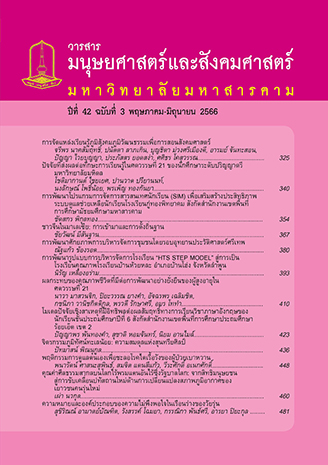Development of a Student Information Management (SIM) Program to improve the efficiency of the student support system at Kuthong Pittayakom School under the Maha Sarakham Secondary Education Area Office
Main Article Content
Abstract
The objectives of this study are to 1) study Student Information Management (SIM) to strengthen the efficiency of the student support system at Kuthong Pittayakom School, under the Mahasarakham Secondary Education Service Area Office, and 2) develop a Student Information Management (SIM) program to strengthen the efficiency of the student support system at Kuthong Pittayakom School, under the Mahasarakham Secondary Education Service Area Office. The sample for this study consisted of 125 northeastern secondary school administrators, a sample without replacement. Kuthong Pittayakom School Student Support System, which is linked with the Mahasarakham Secondary Education Service Area Office. For The orifical fidelity or construct validity assesses the consistency of the measurement model with empirical data in the confirmatory factor analytic model (specifically, chi-square value, chi-square value (square root value of mean, quadratic tolerance of estimation), and analyzes the data using Wilcoxon's Matched Pairs Signed-Ranks Test. The research showed: 1. A student support system model improves student support system efficiency It is structurally direct and consistent with empirical results. chi-square = 127.784, df = 155, p-value =.946, RMR =.133, GFI =.907, AGFI =.873, IFI = 1.008, TLI =.924, CFI = 1.000, RMSEA = 0.000 2. Development of student information management (SIM) programs to improve the efficiency of the student support system at Kuthong Pittayakom School, affiliated with the Mahasarakham Secondary Education Service Area Office. Before and after development, differed statistically significantly at the level of.05, with a higher post-development average than before development.
Article Details
References
พิณสุดา สิริธรังศรี. (2552). รายงานการวิจัย เรื่อง ภาพการศึกษาไทยในอนาคต 10-20 ปี. กรุงเทพฯ: พิมพ์ ดีการพิมพ์.
สุกัญญา แช่มช้อย. (2558). ภาวะผู้นำทางเทคโนโลยี: การนำเทคโนโลยีสู่ห้องเรียน และโรงเรียนในศตวรรษ ที่ 21. JOURNAL OF EDUCATION NARESUAN UNIVERSITY, 17(4), 216-224.
Ackoff, R. L. (1999). Alternative types of planning. Ackoff’s Best: His Classic Writings on Management, Wiley, New York, 104-114.
Goleman, D. (2011). Intelligenza emotiva. Bur.
Guilford, J. P. (1970). Creativity: Retrospect and prospect. The Journal of Creative Behavior, 4(3), 149-168.
Haines, D. E., & Pollock, K. H. (1998). Estimating the number of active and successful bald eagle nests: an application of the dual frame method. Environmental and Ecological Statistics, 5(3), 245-256.
Lombardo, M. M., & Eichinger, R. W. (1996). ALL RIGHTS RESERVED.
Picciano, A.G. (2011). Educational Leadership and Planning for Technology (5th Ed). Columbus, OH: Pearson Education
Riggio, R. E., & Reichard, R. J. (2008). The emotional and social intelligences of effective
leadership: An emotional and social skill approach. Journal of managerial psychology.
Sánchez-Elvira Paniagua, A. & Simpson, O. (2018). Developing Student Support for Open and Distance Learning: The EMPOWER Project. Journal of Interactive Media in Education, 2018(1),. Retrieved September 20, 2022 from https://www.learntechlib.org/p/190981/.
Skager, R. (1978). Lifelong Education and Evaluation Practice, Hamburg. UNESCO Institute for Education and Pergamon Press.
Sheninger, E. C. (2014). Digital leadership : changing paradigms for changing times. United States of America: Corwin
Senge, P. M. (1990). (The art and practice of the learning organization Vol. 1). New York: Doubleday.

